As parents, it is so important that we teach our kids how to interact safely with dogs, but as dog owners it is so important to encourage our dogs to be calm, happy and relaxed around children. This isn’t always easy as young children can be quite scary to our dogs, especially toddlers as their behaviours can be erratic and unpredictable. Given our dogs can’t actually talk to us and tell us how they are feeling, learning to read your dogs body language is essential too. Dogs will always let us know when they are not feeling comfortable in a situation and it is our job as the parent and/or the dog owners to see these signs and intervene and seperate them before it’s too late. We can also help our dogs by creating positive associations around children, plus teaching our dogs basic manners and skills will help them to be able to settle more easily around children and give you options to redirect them before unwanted behaviours happen.
Using great management strategies, like baby gates, crates and play pens will also be incredibly important to help give your dog a break and a safe place to go. Click here to see what Family Paws recommend for different management ideas .
In this article I am going to give you five skills you can teach your dog which will help to manage and redirect them when around children. I will give you the steps to teach these skills to your dog and I will give you examples of when you might use each of these skills.
Five Important Skills to teach your Dog when Around Young Children
Like any training you do with your dog you must be patient and persistent. Start out in a quiet place with minimal distractions and work your way up to harder, busier environments. It will be much easier teaching these skills to your dog first when the kids are not around. Remember to always reward the good behaviours and ignore or redirect the unwanted ones. If you find your dog isn’t getting it, go back a step, go slower and reward more generously. The more you practice these skills, the better results you will get.
Skill One: “Sit”
Teaching your dog to sit is a fantastic life skill! Sit is like Please – it is good manners. Plus it’s an easy one for them to learn. You can use this when you have people come into your house. Instead of your dog jumping on guests, you can ask your dog to sit and reward them for it – this is an example of when you would use one of these skills to redirect your dog from doing an unwanted behaviour. Rather, we show them what we want them to do and we heavily reward them for it.
Teaching your dog to sit around children is incredibly important for example when your dog comes running towards you – I have taught Cooper that when he comes to me, he must sit before he gets his treat, he is a big dog and I would hate for him to knock a child over. Now, when my kids call Cooper to them, he knows to sit before they will give him a pat.

Here’s how to teach it:
Step 1. Show it. Lure your dog into a sit by putting the treat up to his nose and moving the treat slowly over his head toward his tail. Keep the treat lure close to your dog’s nose—if you move your hand up too quickly or too far away from his mouth, he may give up and lose interest.
Step 2. Pay it. As soon as your dog’s bottom hits the ground praise and treat. Repeat as many times as you can, so long as you and your dog are still enjoying yourselves. Praise and treat every sit.
Step 3. Repeat it. Repeat the exercise several times. As soon as your dog sits reliably, it is time to fade the food lure.
Step 4. Fade it. Take the treat out of your hand and repeat step 1-3 without the food lure. Do this until your dog sits reliably using only a hand signal without you holding the food in your hand. When he does, you’re ready to add a verbal cue.
Step 5. Say it. Tell your dog, “Sit” in a cheerful tone of voice.
Step 6. Show it again. Pause a second, then lure your dog into a sit using the hand signal.
Step 7. Pay it again. As soon as your dog’s bottom hits the ground praise and treat. When you and your dog are having repeated successful trials, move on to fade the hand signal.
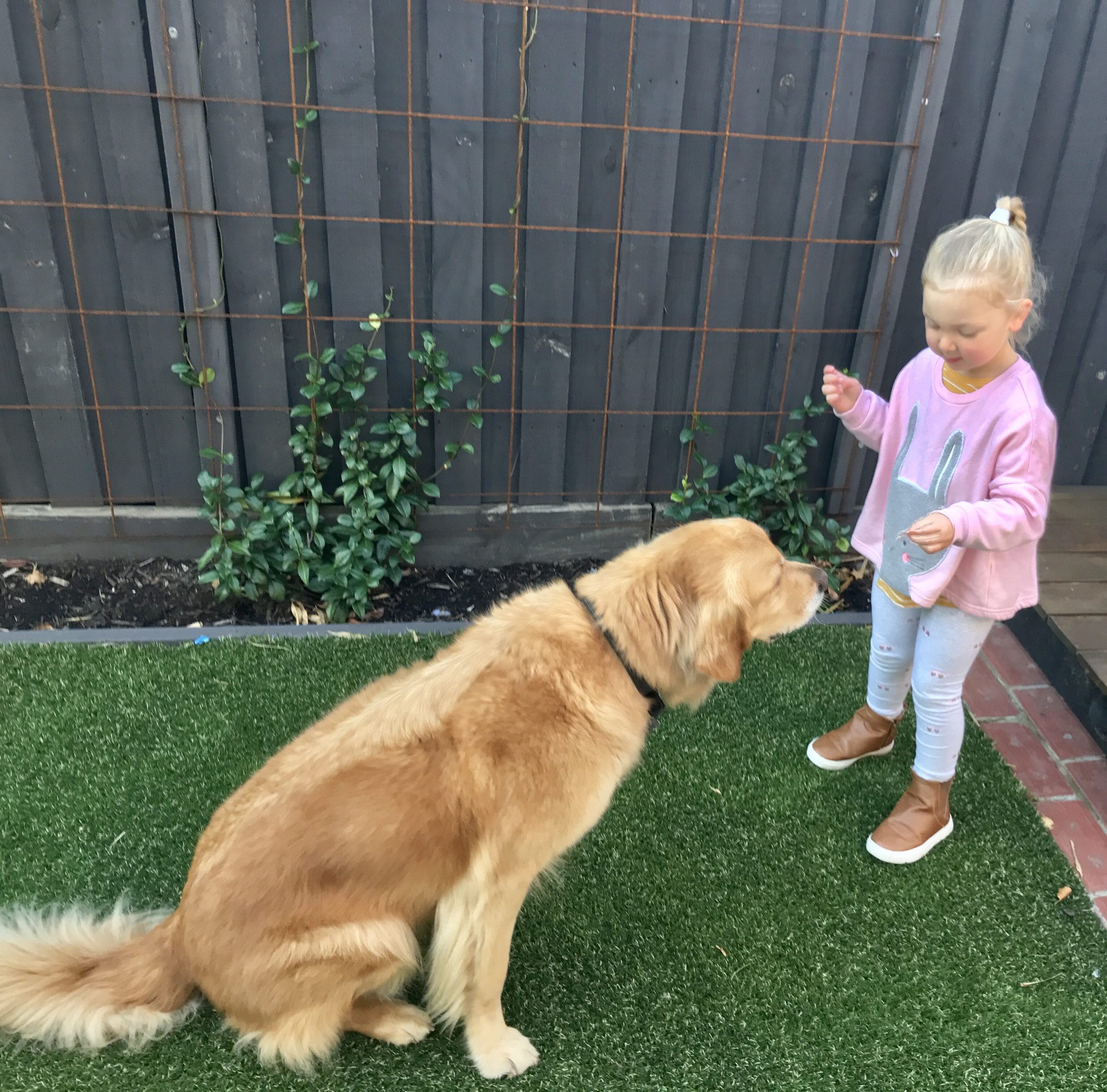
Skill Two: “Down”
Teaching your dog to lie down is another fantastic skill in life but also around children. It’s a great way to include them in your daily activities, by giving them something to do but it is also a great way to teach them to settle. For example, when you are changing your child’s nappy, you can call your dog in with you and ask them for a “down”. Give them a yummy treat when they do it. Another great time to use this is during tummy time. Babies do a lot of tummy time in those early few months of life, so teaching your dog to do a “down” with you in between dog and and baby of course, will be a really nice way to include your dog and then even be able to give him a nice pat when he does it.
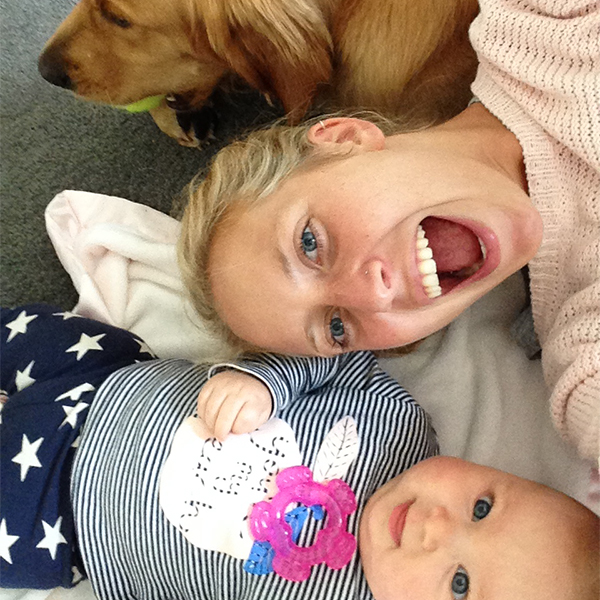
Here’s how to teach it:
Step 1. Show it. Lure your dog into a down by putting the treat up to his nose and slowly moving the treat down to the ground. Keep the treat close to your dog’s nose—if you move your hand down too quickly and too far away from his mouth he may give up and lose interest.
Step 2. Pay it. As soon as your dog’s knees and elbows hit the ground, praise and treat. Keep treating him to thank him for staying in the down. After a few seconds tell him, “Okay!” and encourage him to get up. If he gets up before you release him, say, just lure him back into a down. Release him more quickly this time, then keep practicing to work up to longer downs.
Step 3. Repeat it. Repeat steps 1-3 many times. When your dog gets into the down quickly, it is time to fade the food lure.
Step 4. Fade it. Take the treat out of your hand and repeat step 1-3 without the food lure. Do this until your dog does a down reliably using only a hand signal without you holding the food in your hand. When he does, you’re ready to add a verbal cue.
Step 5. Say it. Hold a treat in your hand. Tell your dog, “Down” in a cheerful tone of voice.
Step 6. Show it again. Pause a second, then lure your dog into a down using the hand signal.
Step 7. Pay it again. As soon as your dog’s knees and elbows hit the ground, praise and treat. When you and your dog are having repeated successful trials, move on to fade the hand signal.
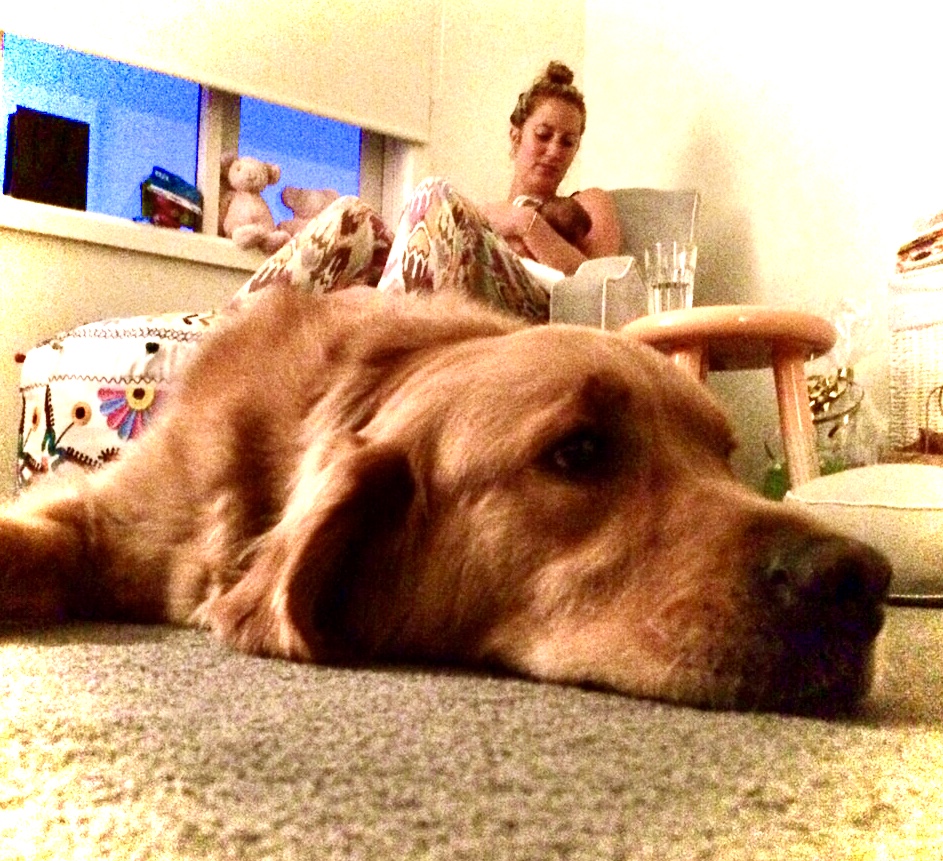
Skill Three: “On your bed”
Teaching your dog to go to their bed and chill is another fantastic skill for them to master when children are around. However, it’s equally important to teach children that when a dog is lying on their bed- we leave them! You never know how a sleeping dog will respond if he get’s startled and woken. This skill can be used when you are all sitting having dinner – instead of having your dog being under the table which can be dangerous if a chicken bone or a corn cob is dropped for example, you can ask them to go to their bed instead. And of course you will heavily reward them for this behaviour. It’s also a good skill for your dog to know when you have people over. If it’s safe for your dog to be roaming freely, but he’s a little unsure of what to do with himself, asking him to go “on your bed” should help him to relax and settle.
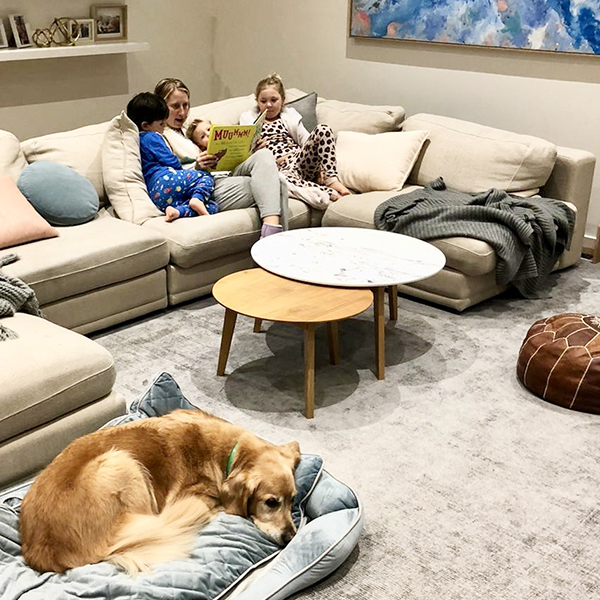
Here’s how to teach it:
Step 1. With a treat in your hand, tell your dog, “Go to your bed” in a cheerful tone of voice and point to his bed (you can also use a mat or a towel – it doesn’t need to be his actual bed).
Step 2. Pause a second or two, then lure your dog onto his mat by putting the treat up to his nose and slowly moving it over the mat. If you move your hand too quickly or too far away from his mouth he may give up and lose interest.
Step 3. As soon as your dog has four paws on the mat, say “yes” and give a treat.
Step 4. Tell your dog, “Down.” Give the hand signal or lure it if your dog needs help. When he lies down, treat him. Continue to treat to keep your dog on the mat. After a few seconds, tell your dog, “Okay,” and allow him to get up.
Repeat steps 1-4, gradually increasing the amount of time you ask him to stay on the mat.

Skill Four: Recall / “Come”
Teaching your dog to Come when you call them is a life saving skill!! For example if your dog runs out the front door and you need to get them back in. Or if your dog runs off at the dog park. But teaching your dog to come when you call them is also a fantastic skill you can use in the house to redirect them as you see a scary/unpleasant situation about to unfold in front of you with the kids – for example, your dog is doing his own thing or resting and your toddler is crawling towards him – instead of jumping in and getting angry at your toddler – rather redirect by calling your dog over to you and keep it positive. Same goes for when your kids are busy minding their own business, maybe eating a snack and you see your dog approaching them – don’t shout and get angry, rather use a recall and call your dog over to you and then praise.
This will help to keep a positive association between kids and dogs. If we get angry each time they approach each other, this can cause a negative association between them which is something we do not want to happen.
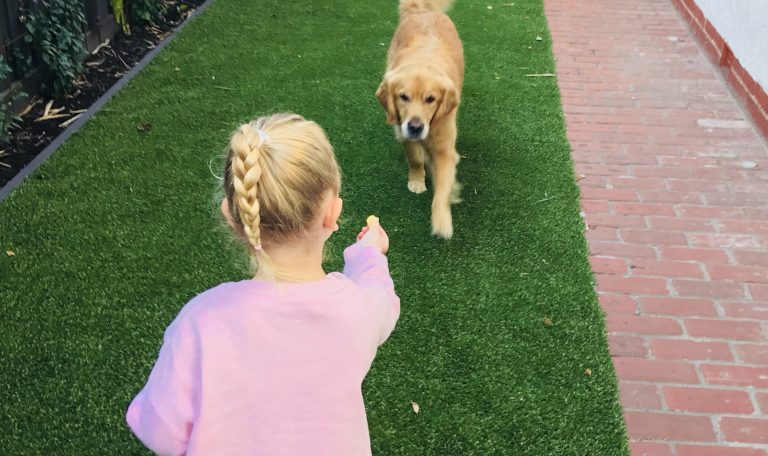
Here’s how to teach it:
Start out teaching this with minimal distractions, when the kids are in bed, in the house is best, then build up to your garden. Get it right in these places, before moving to highly distractible places like the dog park. When working outside, practice in enclosed spaces or on a long leash until your dog’s recall is reliable.
Step 1. Have two people standing about 2m apart to start, both must have high value treats with them. One person is to hold ONE treat out in your hand for him to see and call your dog in a nice, loud cheerful tone. Say your dogs name – then “Come”, for example, “Cooper, come!”. Your dog’s name by itself is not a recall. As soon as he gets to you, reward with the treat.
Step 2. As soon as he’s had that first treat, the next person is to call the dog in the same cheerful manner and hold ONE treat out in your hand for him to see. As soon as the dog gets to you, praise and reward.
If your dog doesn’t come when you say his name, don’t repeat the cue. Walk up to him, stick the treat under his nose and lure him back to you. Give him the treat when you get back to your starting point. If he didn’t follow that treat, you either need higher value treats or a shorter distance between the two of you. Repeat this over and over. It should be just like a game of ping pong.
Step 3. Once the dog starts to understand the game, start to step further and further back, increasing the distance between the two people. The aim is that your dog’s recall will get so good, that eventually you will be able to hide around the house and call your dog to you and he will be able to find you. This will then be able to translate when you are out and about, like at a busy dog park.
The 5 rules of recall:
1. Never call your dog for anything unpleasant. Such as nail clipping, bathing, or having his leash clipped on to go home from the park.
2. Never call your dog if you are not sure he will come. All recalls should be successful recalls.
3. If you call your dog and he doesn’t come, you must make it happen. Run over to him and put a treat in front of his nose, backing up as you get his attention so he follows you.
4. Never repeat the request. Resist the urge to call over and over and over. It only teaches your dog to tune out the cue. Call once and, if necessary, use rule 3. Make the recall happen.
5. Fabulous recalls get fabulous rewards. If you want your dog to stop whatever interesting doggie thing he is doing and come running to you, make it worth his while. Use extra yummy treats—no dry biscuits here!—or a well-thrown ball, if that is your dog’s fancy.
Skill Five: “Give” / “Thank you”
This skill teaches your dog to give up something he has put in his mouth. If your dog has “accidentally” put a kids toy, a corn cob, a shoe, whatever it is, in his mouth, you need to have a word that he understands that will open his mouth and release it. This is a very important life skill (have I said that now about all of the skills?!). Especially if he were to put something dangerous in his mouth like Panadol or even just a disgusting dirty nappy. This is also a skill that can be used when playing the game “fetch” if your dog isn’t giving the ball up.
My moto is – never take, always trade! So if your dog steals something they shouldn’t have, don’t chase them and take it from them! They will think it’s a fantastic game and run away from you! We want them to learn that if you take something from them, they will get something better.
As a side note – some foods can be quite dangerous for dogs, especially things like sultanas, grapes, chocolate, cooked bones, corn cobs, etc so it is important that we teach our dogs not to jump at food the second it falls on the floor and most certainly not to snatch it from a child’s hand or plate. I have written an article on managing feeding time with kids and dogs, so make sure so have a read of that too.

Here’s how to teach it:
Step 1. Offer your dog a toy he is likely to pick up in his mouth. You may have to entice him by shaking it in front of him in a playful way.
Step 2. Once your dog is holding the toy in his mouth, present a food treat in front of his nose. As soon as he drops the toy give him the treat.
Step 3. Repeat steps 1 and 2 a few times. If your dog is too focused on the treat to pick up the toy, take a short break and then try enticing him to play again.
Step 4: Add a verbal cue: Once he has the toy in his mouth, say “give” or “thank you” just before you present the treat in front of his nose. As soon as he drops the toy, give him the treat. It’s up to you which word you use just make sure everyone in the family is using the same one.
Step 5: Continue practicing, slowly increasing the time between your verbal cue and offering the treat in front of his nose. You’ll know your dog understands the cue when he starts to drop the toy before you show him the treat.
Step 6: Mix it up! Once your dog has the hang of dropping on cue, try rewarding drops with a game of fetch instead of a treat. When he drops the toy, toss it and encourage him to go get it.
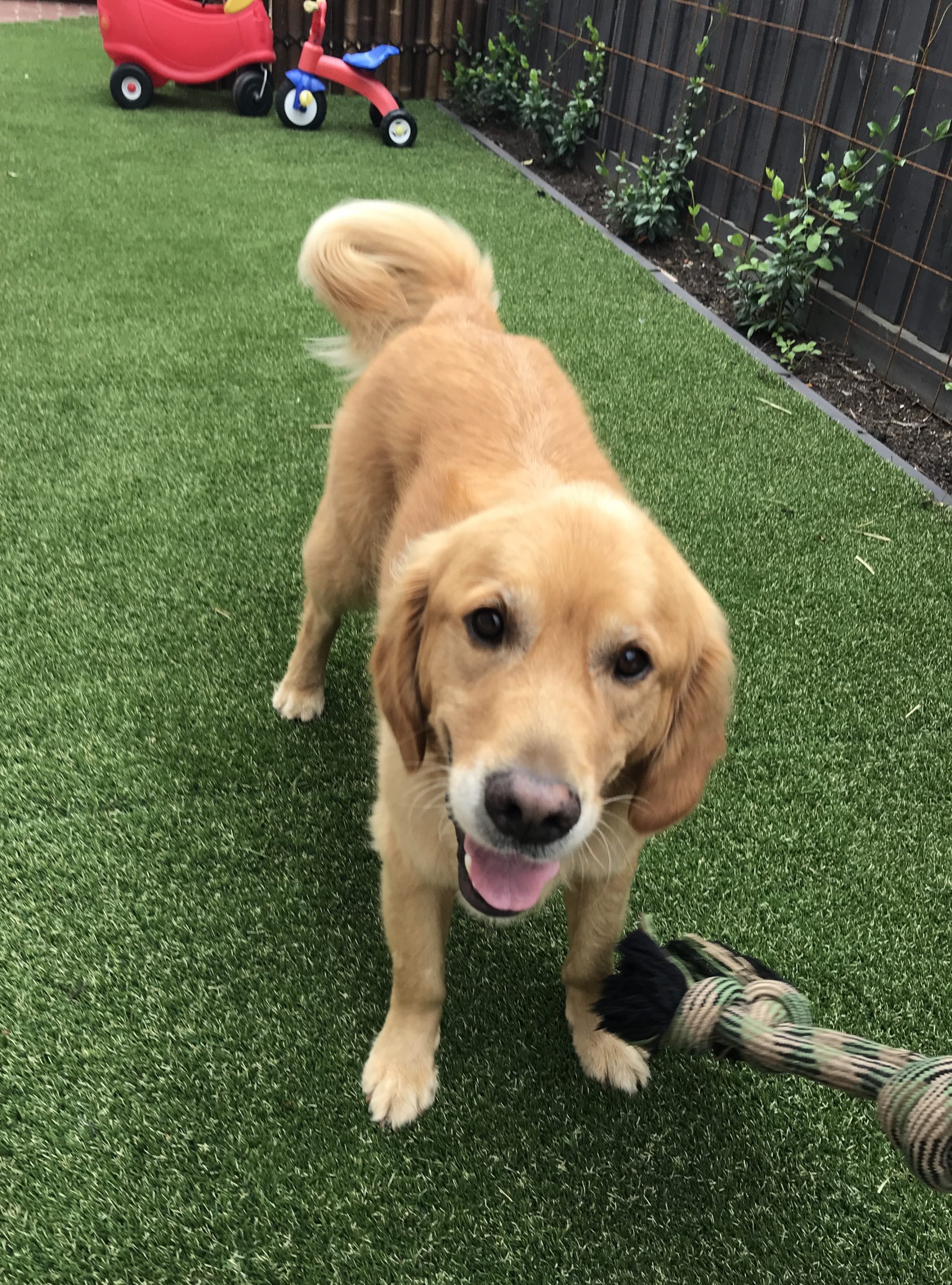
Just a reminder that if you cannot actively supervise your dog and child when together then I strongly advise using baby gates, crates or play pens. I promise it is not a cop out, rather look at it as a fantastic management tool for your dog. Children can be stressful for your dog, so it’s just giving them somewhere they can relax and know they are safe. Give them a nice treat and they’ll thank you for it. Click here for what Active supervision looks like.
For more info on child and dog safety and how dogs communicate make sure to have a read of these articles:
- “Stay Calm and stand like a TREE” What to do when you want a dog to calm down or move away
- Our Dogs Are Always Communicating Let’s Learn To Understand Them And Help Prevent Dog Bites To Children
- Good Intentions Aren’t Enough. We Want Dogs To Enjoy Their Encounters With Children Rather Than Just Tolerating Them.
- Three steps to Teach your child how to safely say hello to dogs
- Teaching your child how to interact with dogs and some important signs to look out for
- Lead by example to show your child how to interact appropriately with dogs
Finally, if you think your dog is a risk to your children, please seek the help from a dog trainer/behaviourist ASAP. If you have any questions on this topic or would like some help or guidance with any of it, please feel free to leave a comment below or send me an email. This is such an important topic. Please spread the word and share this article around to all dog owners.
Mel xox
PS. Make sure to head to our SHOP if you haven’t already! Spoil yourself and your dog!!




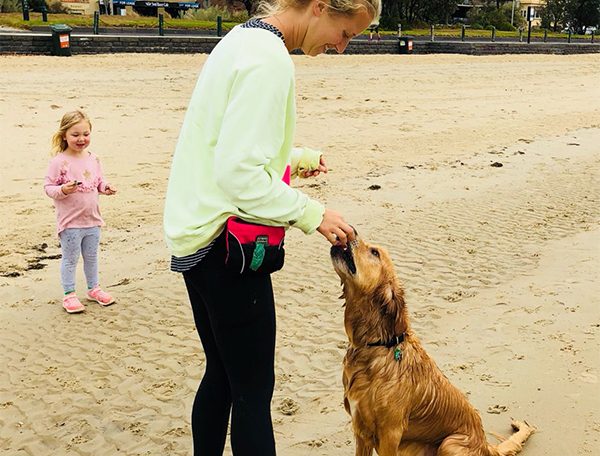
Comment (1)
Wiki May 17, 2018 at 8:38 pm
Hello ,
I saw your tweet about animals and thought I will check your website. I like it!
I love pets. I have two beautiful thai cats called Tammy(female) and Yommo(male). Yommo is 1 year older than Tommy. He acts like a bigger brother for her. 🙂
I have even created an Instagram account for them ( https://www.instagram.com/tayo_home/ ) and probably soon they will have more followers than me (kinda funny).
I have subscribed to your newsletter. 🙂
Keep up the good work on your blog.
Regards
Wiki